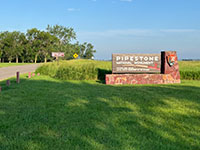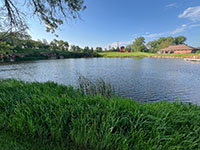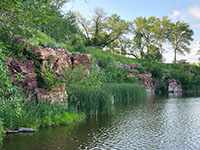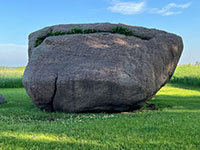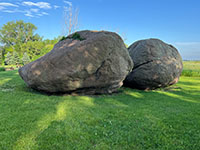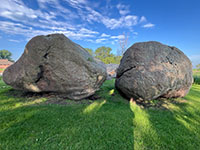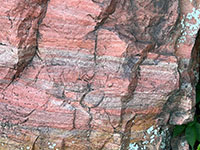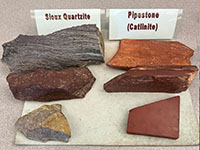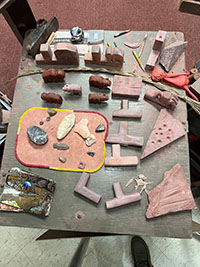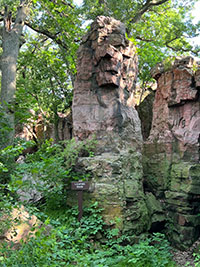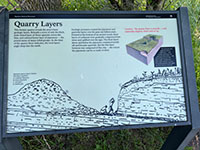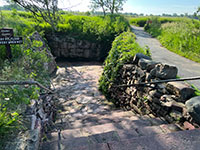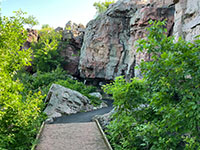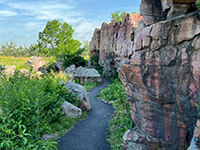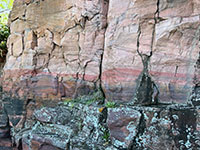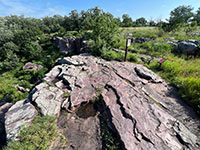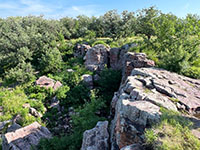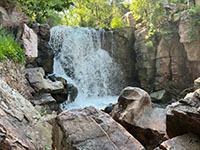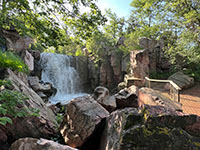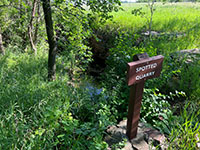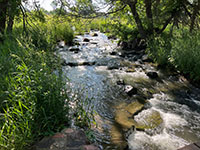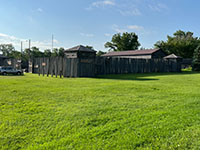
Pipestone National Monument, Nebraska
Click On Images For A Larger View. |
Return to Geology of National Parks main page |
Pipestone National Monument was founded by congress in 1937 to protect pipestone quarries, sacred to regional indigenous cultures. It is tall-grass prairie preserve that is host to amazing geology and paleohistory related to the mining of "pipestone" (catlinite) used in the manufacture of pipes and other stone artifacts. The park's visitor center is host to numerous exhibits relating to the historic and prehistoric quarries along Pipestone Creek and vicinity. A scenic 1.5 mile long loop trail starts at the Visitor Center and follows a scenic low outcrop belt of Precambrian-age Souix Quartzite. This massive quartzite layer overlies a layer of "catlinite" a metamorphosed layer of volcanic ash with a relatively soft uniform texture ideal for carving into artifacts, stone effigies, and other items. Learn about the park geology on the website listed below. |
 Map showing the location of Pipestone National Monument in western Minnesota. (Click on map for a larger view.) |
| The gallery of pictures below illustrate the landscape features and geology in the park, and displays in the park's visitor center. Figure 1 shows the park entrance sign on 111st in Pipestone, Wisconsin. Figure 2 is a view of the tall-grass prairie habitats preserved in the park. Figures 3 and 4 show a lake-filled quarry with outcrops in the Leon H. Moore Park (a developed park area within the national monument). Figures 5 to 8 show large granite boulder that are glacial erattics left behind by the Ice Age continental ice sheet that covered this region. The three large granite boulders are called the Three Sisters and have sacred significance to the local indigenous Native Americans in the region. Figure 9 shows a close-up view of the coarsely crystalline texture of the granite. Figure 10 is a close-up view of the brightly colored outcrop of Souix Quartzite of Precambrian age that is exposed troughout the park area. Figure 11 shows display samples of both Souix Quartzite and the catlinite (pipestone) quarried in the park area.Figures 12 to 14 illustrate some of the Visitor Center displays that show pipe making from pipestone. Figures 15 through 31 show views along the 1.5 mile loop trail that starts at the Visitor Center. The trail follows an outcrop belt of Souix Quartzite along the Pipestone Creek drainage and leads to history quarry locations and scenic Winnewissa Falls. Figure 32 shows Historic Fort Pipestone (not part of the national monument, but is located near the park entrance). |
| This page is <https://gotbooks.miracosta.edu/gonp/pipe/> Last modified 7/22/2024 |
